-
How to start trading?
If you are 18+ years old, you can join FBS and begin your FX journey. To trade, you need a brokerage account and sufficient knowledge on how assets behave in the financial markets. Start with studying the basics with our free educational materials and creating an FBS account. You may want to test the environment with virtual money with a Demo account. Once you are ready, enter the real market and trade to succeed.
-
How to open an FBS account?
Click the 'Open account' button on our website and proceed to the Trader Area. Before you can start trading, pass a profile verification. Confirm your email and phone number, get your ID verified. This procedure guarantees the safety of your funds and identity. Once you are done with all the checks, go to the preferred trading platform, and start trading.
-
How to withdraw the money you earned with FBS?
The procedure is very straightforward. Go to the Withdrawal page on the website or the Finances section of the FBS Trader Area and access Withdrawal. You can get the earned money via the same payment system that you used for depositing. In case you funded the account via various methods, withdraw your profit via the same methods in the ratio according to the deposited sums.
Truncation in the Elliott Wave Theory
Elliott Waves is a type of graphical method of technical analysis based on identifying repeating wave cycles of price movements. According to this method, there are different types of waves, and under certain circumstances, such a phenomenon as truncation appears.
What is truncation in trading
In most impulses, the fifth of the Elliott waves extends beyond the extremum of the third wave, but sometimes the fifth wave may not reach the end of the third wave. This phenomenon is called truncation or truncated wave. In other words, sometimes a fifth wave could be weak and end without reaching the end of the third wave. A situation like this can occur at the fifth wave of an impulse or ending diagonal. It is rare if even possible to have a truncated fifth wave of a leading diagonal. Usually, a truncation happens after a strong third wave. You can track the movements of different types of waves on the trading platforms.
Real truncation examples
As you can see on the chart below, there is an upward impulse in wave ((i)) with a huge extension in wave (iii). Wave (iv) finished as a flat pattern (we are going to examine it in the next articles). There is also a five-wave price movement from the ending point of wave (iv), which is followed by a decline. Thus, the fifth wave of wave ((i)) has turned out to be truncated.
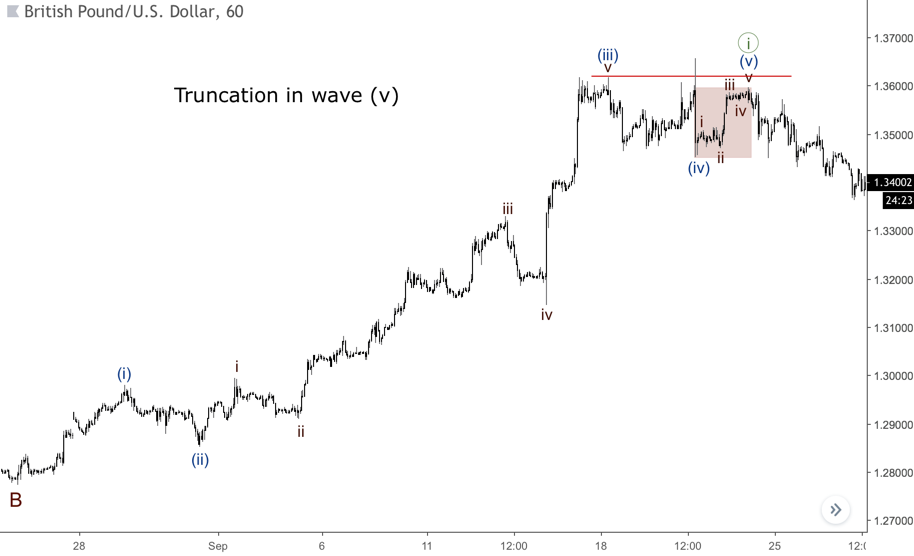
Types of truncated waves
Truncated Elliott waves can be of two types:
Impulse wave
An impulse wave is a separate directional market movement that determines the direction of a trend and the most common type of driving wave. In an impulse, the fourth wave does not overlap the territory of the first wave.
Diagonal wave
Diagonal waves represent a movement pattern that has not become an impulse due to the presence of one or two correctional traits. For diagonal triangles, as with impulse waves, the main feature is that none of the opposing sub-waves can roll back more than the size of the last active sub-wave.
There is a distinction between leading diagonal and ending diagonal waves. Ending diagonal is a special type of wave developing in place of the fifth wave, while the past movement of the third wave went “too fast and too far”, as Elliott described.
How to recognize truncation
It is quite challenging to recognize a truncation in the real-time wave counting, so here are some tips:
1. In most cases, a truncation forms in impulses with huge third waves. Thus, in such a case, we should watch out for a possibility of a failure in the fifth wave.
2. At the same time, there is always a choice if we have a five-wave price movement from the ending point for the fourth wave. But the market does not move beyond the end of the third wave. In a situation like this, the five-wave price movement could be wave one of the fifth wave or the fifth wave itself. The key point here is what happens after this five-wave price movement after the fourth wave. If we have a local three-wave correction, then it is likely that the fifth wave is going to be continued. However, if a five-wave price movement forms instead, we should be ready to face a truncation in the fifth wave.
3. As we can see on the chart below, sometimes we could face a truncation even if the third wave is not huge. Here wave ((3)) is little more than wave ((1)), but wave ((5)) could not break the low of the third wave. Such a case usually happens when a larger trend is running out of steam. Just to be clear, it is very risky to try identifying a truncation in real time, so we could only assume that when a five-wave price movement forms in the opposite direction.
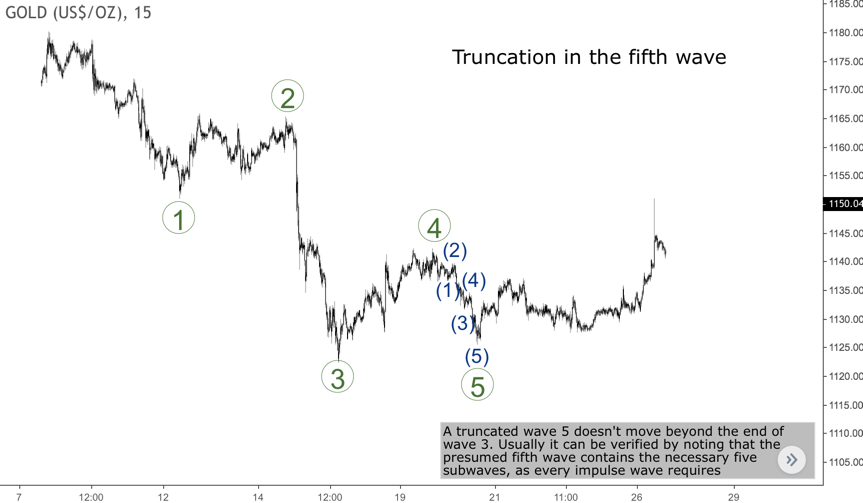
4. Let us move to the next example, which shows a situation with a small truncation. The high of wave ((v)) is narrowly lower than the ending point of wave ((iii)). A five-wave decline arrives afterwards, which confirms that the truncation has taken place. Pay attention to the fact that wave ((iii)) was long, which pointed to a possibility of a truncation.
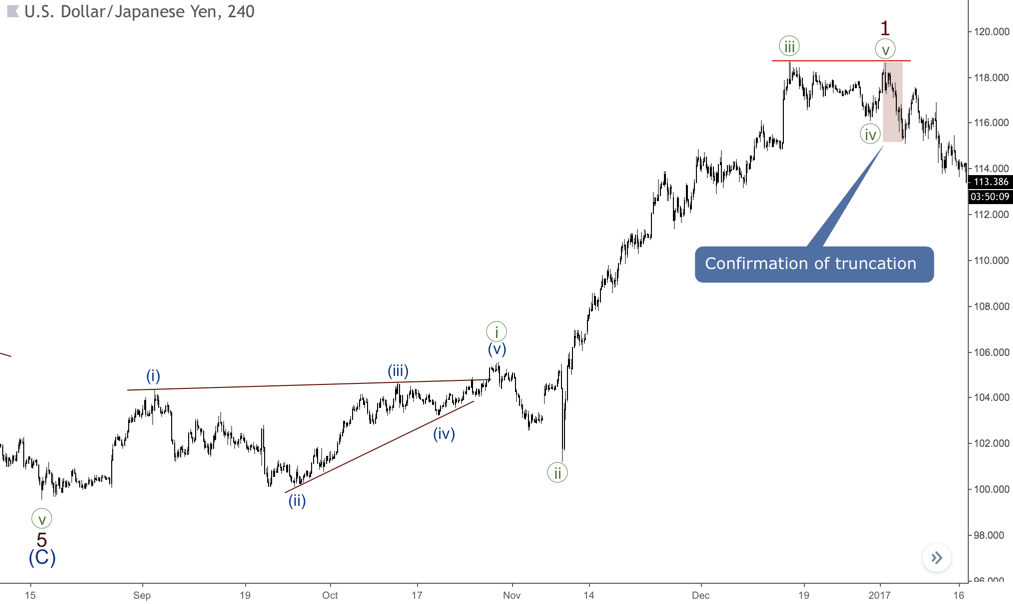
5. Also, the fifth wave of an ending diagonal pattern could be truncated as well. As you probably already know, in most cases ending diagonals consist of zigzags, so the truncated fifth wave of this pattern could form like a zigzag, not a five-wave price movement like in impulses. It is common to have a truncation in expanding ending diagonals because there is the same logic as in impulse waves. The third wave of an expanded diagonal is usually longer than the first wave, so the market is exhausted and the fifth wave simply does not have enough strength to reach the ending point of the third wave.
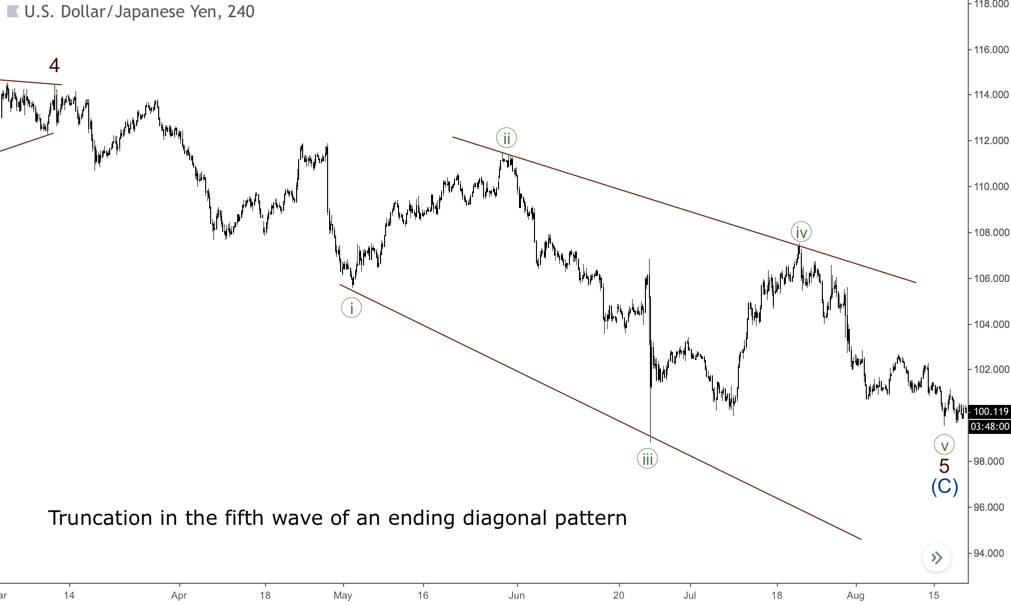
6. There is another tip to recognize a truncation in expanding diagonals. Because of the fifth wave supposed to be a zigzag, wave C of this pattern could be an ending diagonal. Thus, if the ending point of a diagonal in wave C of the fifth wave does not reach the extremum of the third wave, there is a reasonable chance to have a truncation. An example of this situation is on the chart below. There is a pullback from the diagonal's upper side, which led to a massive bearish rally.
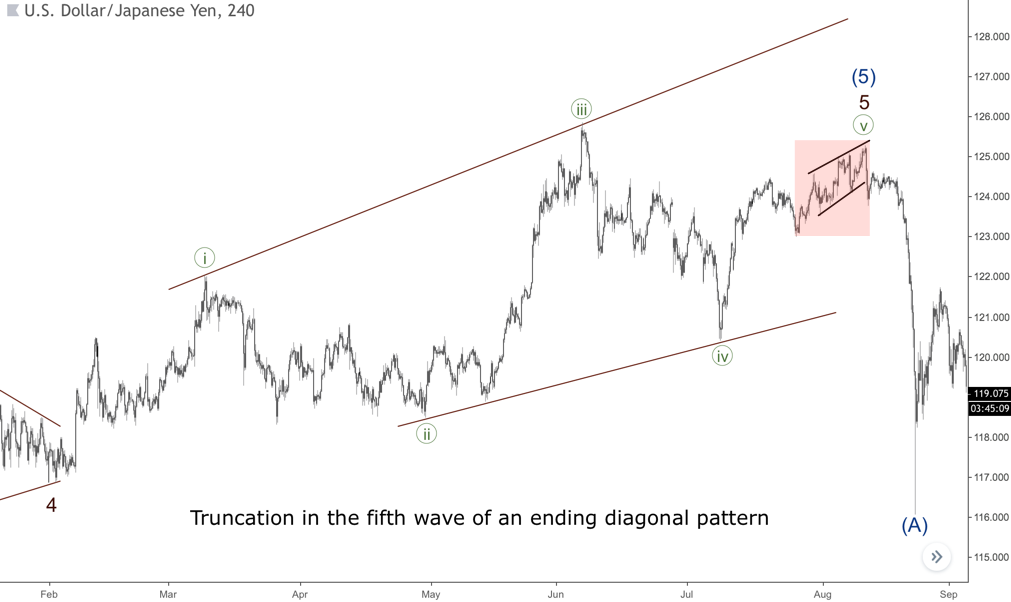
The bottom line
According to the Elliott method, the fifth wave of impulses or ending diagonals can be truncated. The form of the fifth truncated Elliott wave is not affected. In impulse waves, the truncation is formed as an impulse or diagonal, and in diagonal waves as a zigzag. A truncation in the fifth wave of leading diagonal is extremely rare. Five-wave price movement in the opposite direction confirms the truncation.
2022-09-29 • Updated
Other articles in this section
- Structure of a Trading Robot
- Building a Trading Robot without Programming
- How to Launch Trading Robots in MetaTrader 5?
- Algorithmic Trading: What Is It?
- Fibonacci Ratios and Impulse Waves
- Guidelines of Alternation
- What is a triangle?
- Double Three and Triple Three patterns
- Double Zigzag
- Zig Zag and Flat Patterns in Trading
- Advanced techniques of position sizing
- Ichimoku
- What is an extension?
- Ending Diagonal Pattern
- How to trade gaps
- Leading diagonal pattern
- Wolfe waves pattern
- Three drives pattern
- Shark
- Butterfly
- Crab Pattern
- Bat
- Gartley
- ABCD Pattern
- Harmonic patterns
- What is an impulse wave?
- Motive and corrective waves. Wave degrees
- Introduction to the Elliott Wave Theory
- How to trade breakouts
- Trading Forex news
- How to place a Take Profit order?
- Risk management
- How to place a Stop Loss order?
- Technical indicators: trading divergences








